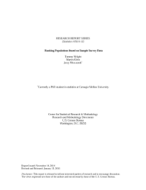
An official website of the United States government
Here’s how you know
Official websites use .gov
A .gov website belongs to an official government organization in the United States.
Secure .gov websites use HTTPS
A lock (
) or https:// means you’ve safely connected to the .gov website. Share sensitive information only on official, secure websites.
-
//
- Census.gov /
- Library /
- Census Working Papers /
- Ranking Populations Based on Sample Survey Data
Ranking Populations Based on Sample Survey Data
Ranking Populations Based on Sample Survey Data
Abstract
Assume K populations with associated respective real-valued parameters θ1, θ2, ..., θK. While the values of θ1, θ2, ..., θK are unknown, we seek to rank the K populations from smallest to largest based on estimates of these unknown values. If the statistic θˆk is an estimator of θk for k = 1, 2, 3, ...,K based on sample survey data, it is a common practice to rank the K populations based on the ranking of the observed values, θˆ1, θˆ2, ..., θˆK, that is, θˆ(1) ≤ θˆ(2) ≤ · · · ≤ θˆ(k)≤ · · · ≤ θˆ(K). For example, the U. S. Census Bureau’s American Community Survey (ACS) produced 85 different (explicit) rankings of the K = 51 states (actually 50 states and Washington, D.C.) based on observed sample estimates during 2011. One of those rankings ranks the states based on θˆk, the estimated mean travel time to work for workers 16 years and over who did not work at home (minutes) for state k, where k = 1, 2, 3, ..., 51. Because rankings based on the observed values of the statistics θˆ1, θˆ2, ..., θˆK can vary depending on the variability among the possible samples that could be observed, some statement of uncertainty should accompany the presentation of each reported ranking. Assuming that a nation’s official statistics should be widely understood and robust, this paper reports concepts and empirical results of some methods for stating uncertainty in rankings using ACS data. Beginning with pair-wise comparisons, we limit our focus to some practices, assisted by visualizations, found in the literature from classical central limit theorem based methods and the bootstrap (nonparametric/parametric). We demonstrate using discussion, some theory, real data, and visualizations that all presented methods (4 methods comparing a pair of populations using normal theory and 3 uncertainty measures and their estimates for the estimated ranks using the bootstrap) are simple and easy to implement and that they can be easily explored and tested, especially by national statistical agencies that release rankings of K populations based on sample survey data. All that is needed are the K sample estimates and their associated standard errors.
Others in Series
Working Paper
Working Paper
Working Paper
Share
Related Information
WORKING PAPER
Statistical Research Reports and StudiesSome content on this site is available in several different electronic formats. Some of the files may require a plug-in or additional software to view.
 Yes
Yes
 No
NoComments or suggestions?


Top

